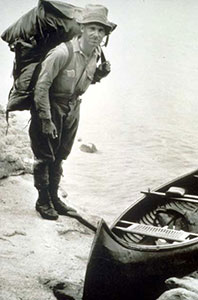Arthur Carhart
 Arthur H. Carhart's life stands as testimony that a good idea will grow and prosper in and of itself. Born in 1892 in Mapleton, Iowa, Carhart graduated from Iowa State College in 1916 with a degree in landscape architecture. In 1919 the U.S. Forest Service hired Carhart as its first full-time landscape architect, even though his official title was "recreation engineer."
Arthur H. Carhart's life stands as testimony that a good idea will grow and prosper in and of itself. Born in 1892 in Mapleton, Iowa, Carhart graduated from Iowa State College in 1916 with a degree in landscape architecture. In 1919 the U.S. Forest Service hired Carhart as its first full-time landscape architect, even though his official title was "recreation engineer."
One of Carhart's first assignments was to survey a road around Trappers Lake in the White River National Forest in Colorado, and to plot several homesites on the lakeshore. Carhart completed the assignment, but recommended to his supervisor Carl Stahl that no development be permitted on the shore. Instead, he strongly urged the best use of the area was for wilderness recreation. This was a bold suggestion for such a young employee and Carhart was quite surprised when Stahl endorsed his recommendations. In 1920 Trappers Lake was designated as an area to be kept roadless and undeveloped. It remains so to this day. That designation marked the first application of the wilderness preservation concept in Forest Service history.
While no one person can be called "Father of the Wilderness Concept," Carhart has been referred to as "the chief cook in the kitchen during the critical first years." Carhart's ideas and vision were shared by another individual who became a significant figure in the wilderness movement. This was Aldo Leopold, then Assistant District (Regional) Forester for District 3 (Region 3) in New Mexico.
On December 6, 1919, Leopold visited with Carhart in Colorado. Following their talks Carhart wrote what was then simply a "memorandum for Mr. Leopold, District 3." This memorandum became one of the most significant records in the history of the wilderness concept:
There is a limit to the number of lands of shoreline on the lakes; there is a limit to the number of lakes in existence; there is a limit to the mountainous areas of the world, and . . . there are portions of natural scenic beauty which are God-made, and . . . which of a right should be the property of all people."
Encouraged by Carhart's kindred spirit, Aldo Leopold went on to champion creation of the Gila Wilderness Reserve in New Mexico, the first Wilderness Reserve, officially designated on June 3, 1924.
Arthur Carhart left the Forest Service in 1923, cutting short his federal career to pursue private practice in landscape architecture, city planning and writing. Before leaving the Forest Service, however, he toured the Quetico-Superior region in Minnesota and recommended these areas of superlative wild scenery be managed for their value as wilderness. Carhart's efforts eventually led to development of what is now the Boundary Waters Canoe Area Wilderness.
During his long life Carhart continued to write about and work for the ideal of wilderness. On March 3, 1973, at the age of 81 Carhart said of himself: "I sometimes wonder how I had the nerve as a young punk to get my superiors turned around on some of these things. I feel real good about how it all turned out."
Working together as Carhart and Leopold did, the Arthur Carhart National Wilderness Training Center and the Aldo Leopold Wilderness Research Institute ensure that recent developments and tested practices in wilderness management are shared throughout the ranks of federal wilderness agencies and with other organizations interested in wilderness preservation.